After WW2, Triumph’s main focus was on twin cylinder motorcycles which were preferred by their chief designer, Edward Turner, over singles. However, by the early 1950’s, Triumph saw a big market for lightweight commuter bikes then mostly based on the use of 2-stroke engines. These included the BSA Bantam and Villiers or AMC engined bikes produced by the likes of James and Frances Barnet. Edward Turner wanted to design a small 4-stroke Triumph single with both the performance and the style to compete against these 2-strokes. The result was the Triumph T15 Terrier shown below that was an extremely handsome looking bike with clear Triumph styling. It went into production starting in the 1954 model year and continued up to and including model year 1957. Compared with the D3 BSA Bantam of that period that produced 5 bhp, the Terrier produced 8 bhp.
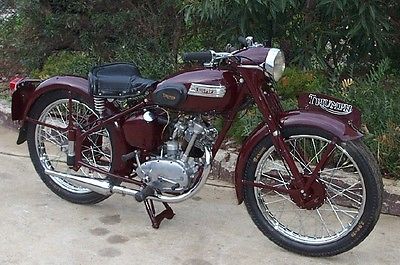
The Terrier was the first Triumph to use a rear plunger rear suspension in which the rear axle is sprung from a rigid back-end frame. Other Triumphs at that time used Edward Turner’s sprung hub design which was not popular. The plunger rear suspension was coupled to telescopic front forks which had been introduced by Triumph into their motorcycle range just after WW2. The Terrier incorporated the distinctive Triumph styled headlight nacelle which covered the top of the fork legs which contained internal springs. It made use of a 3-gallon petrol tank that bolted to the headstock in order to try to brace the weak swan neck design and included Triumph badges and generous knee pads . The Terrier used an oil tank mounted on the right-hand side of the bike, with a combined battery and air filter box on the left. It was fitted with 17″ wheels.
The Terrier was the first unit construction OHV engine made by Triumph which subsequently established the design for later BSA unit singles. It consisted of a pair of crankcases split vertically along the centre line that housed the crankshaft in the front compartment and the 4-speed gearbox in the rear compartment. The crankshaft was supported on a plain bush of the right-hand side through which oil was pumped to the plain big-end bearing and a caged ball bearing on the drive side. On the right-hand end of the crankshaft was a combined bevel drive and toothed pinion. The pinion engaged with a larger pinion on the end of the camshaft which was mounted above it. This in turn operated the two tappets and the pushrods contained in a chrome plated tube to the right of the cylinder. The push rods then operated the inlet and exhaust valves contained in the cylinder head.
The bevel drive on the end of the crankshaft rotated a drive shaft for both the contact breaker distributor and for the oil pump. The distributor was mounted just behind the cylinder on the right-hand side of the crankcase and the dual piston oil pump was mounted below the drive shaft. The gearbox, timing pinions and oil pump were enclosed by an inner timing cover. The gearbox design was identical to most of the later BSA unit singles and was operated via a gear change quadrant and cam plate. The right-hand end of the gearbox lay shaft was supported by the kickstart shaft and incorporated a pawl which engaged with ratchet teeth on the inside of the 1st gear pinion.
The left-hand side of the engine was fairly conventional with a crankshaft sprocket driving the clutch sprocket via a single primary chain. However, in contrast with other Triumph motorcycles at the time, the Terrier was fitted with Lucas electrics which included an alternator, rectifier and ignition coil with the alternator mounted on the left-hand end of the crankshaft. The left-hand side of the engine was enclosed in an attractively sculpture chaincase cover with the Triumph name embossed on it.
The terrier was fitted with a forward sloping cylinder which was parallel to the front down tube. The rocker boxes for the two over head valves was cast into the cylinder head. An oil pipe union was bolted to the left-hand end of each rocker spindle to supply them with oil taken from a T-junction on the return pipe at the oil tank. The engine was fitted with an AMAL 332 carburettor with a detachable float chamber.
Triumph T20 Tiger Cub
The 199 cc T20 Tiger Cub was essentially a larger capacity Terrier. Whereas the Terrier had a bore and stroke of 57 mm x 58.5 mm, the bore and stroke of the Tiger Cub was increased to 63 mm x 64 mm. It was otherwise similar in appearance to the Terrier. The T15 Terrier continued in production up to including model year 1957 using the same plunger frame. However, in the 1958 model year, the Tiger Cub frame was changed to incorporate a swinging arm based rear suspension with twin rear shock absorbers. In this design, the front of the swinging arm was fitted with bushes which rotated on a large diameter spindle that was an interference fit into the from behind the rear down tube. A separate sub-frame for the seat, rear mudguard and top mounts for the rear shock absorber was bolted to the frame just in front of the seat and to either end of the swinging arm spindle. Other than these changes, the Tiger Cub was similar in appearance to the earlier models.
For 1959-61, the main change was the fitting of an enclosure of the rear of the bike in line with the so-called bath tubs fitted to the larger Triumphs at the time. However, for the Tiger Cub, the bath tub was reduced in extent and only covered the front part of the rear wheel. This is now referred to as a bikini cover. Up to this point, the T20 Tiger Cub continued to use the AMAL 332 carburettor but this was changed in 1959 to a Zenith MXZ-C17 carburettor which incorporated its own air filter.
The Tiger Cub continued in this form until 1964 when the engine was re-designed to eliminate the distributor and to replace this with contact breaker points mounted in the outer timing cover. This mainly involved a change in design of this cover with the new auto advance mechanism for the points mechanism essentially bolting on to the end of the camshaft. The T20 Tiger Cub continued in this form into the 1965 season by which time about 100,000 Cubs had been produced.
However, in order to prolong the production line, the Tiger Cub was revamped in 1966 by mating the engine with the frame and other cycle parts from the BSA D7 Bantam to produce the Triumph T20B Bantam Cub with 19″ wheels. As well as providing manufacturing cost savings by sharing parts between the Cub and Bantam, the Cub benefitted from a much stronger frame and longer wheel base. In the following year, the Cub engine was combined with the Bantam D10 frame to produce the T20B Super Cub. However, the hybrid Cubs were not popular with buyers and were not a commercial success.
Triumph Tiger Cub Variants
In addition to the road going T20 models, a large range of competition models were produced over the lifetime of the Tiger Cub. The T20C competition model was first introduced in 1957 with the main changes to the T20 being the use of 18″ wheels, the absence of a centre stand and the fitting of a higher level exhaust system to improve ground clearance. It used rubber gaiters to cover the top of the fork legs and used a slightly smaller fuel tank and shallower mudguards.
The T20C continued into the 1959 season but was then superceded by the T20S Scrambler from 1959-61 and by the T20T Trials and T20SL Scrambler Lights in 1961. These models were fitted with an energy transfer ignition system and direct lighting where necessary, and therefore eliminated the need for the battery box. Instead they were fitted with an air filter box which connected to a AMAL Monobloc carburettor. They were fitted with a 19″ front wheel and 18″ rear wheel. As with the T20C, these two models were fitted with a slightly smaller fuel tank and, unlike all previous models, the T20T and T20SL were fitted with a separate small headlamp. The T20S, of course, did not have any lights fitted. The T20T engine was similar to the road model but the T20S and T20SL were fitted with a sportier camshaft and 9:1 compression ratio piston.
In 1962, the T20 competition model range was revised leaving just the T20 SS Street Scrambler and the T20SH Sports Home. The former was basically a renamed T20SL while the latter was an essentially sportier version of the standard T20 with the larger wheels, a separate headlamp but without the bikini cover. These models continued into model year 1965. The main changes made over this period was the use of the heavy weight Triumph forks from 1964 and the change to the side points engine in the same year.
The final variant of the T20 competition model between 1964-65 was the T20M Mountain Cub which was developed for the US West Coast dirt bike market. It was essentially a trail bike with the off-road features of the earlier T20T and the more sportier engine from the T20S models. The T20M probably now represents the most sought after Tiger Cub competition model.
My Triumph T20 Tiger Cub restoration
The bike I passed my riding test on at the Wembly Test Centre was a Triumph Tiger Cub which I rode around London for about 3 years and also used it for regular rock climbing trips to Derbyshire . At that time, my Cub must have been about 15 years old. It was not in that good a condition and this was made more noticeable because my rock climbing mate rode a Tiger Cub in near factory condition. Nevertheless, my Cub served me very well for thousands of miles although it still amazes me how I managed to do this on such a small motorcycle!
I bought my current Tiger Cub from a very nice retired guy in Liverpool not far from Knotty Ash of Ken Dodd fame. I only paid about £1100 for it following an online auction and felt a little guilty when I trailered it away especially as he claimed to have done a lot of work to restore it. I originally restored the bike about 10 years ago but, over that time, the original paint work had deteriorated and needed to be re-done. Therefore, I recently subjected the bike to a second restoration although this mainly involved a complete re-spray.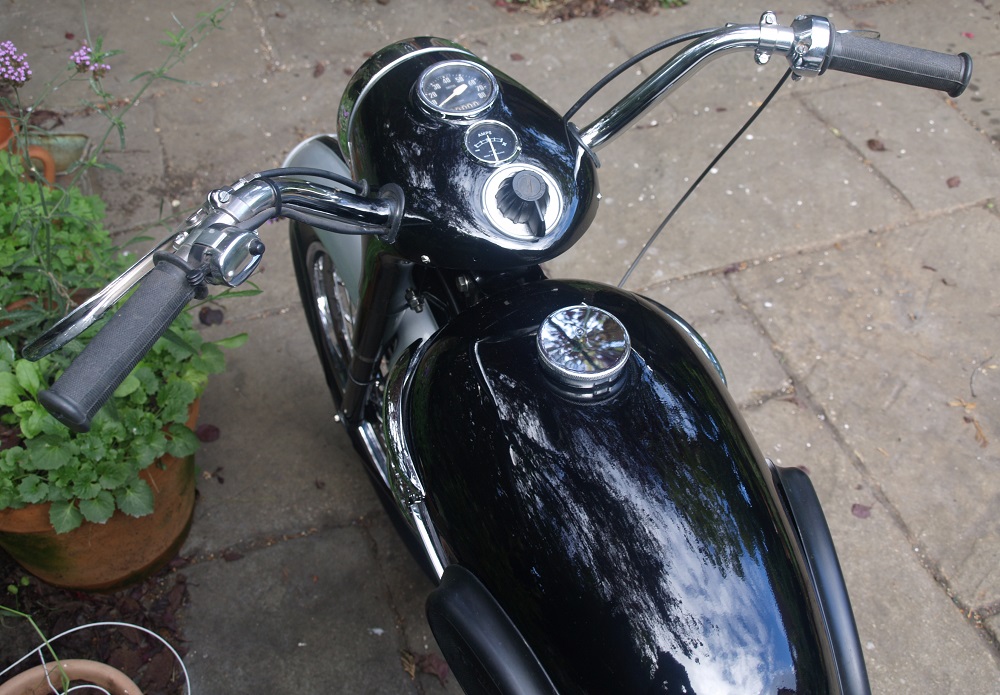
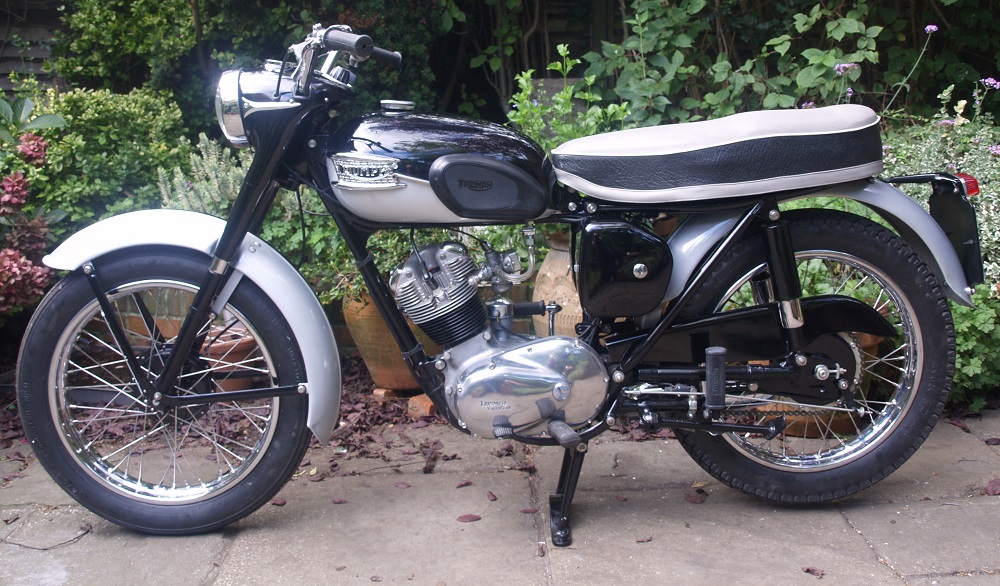
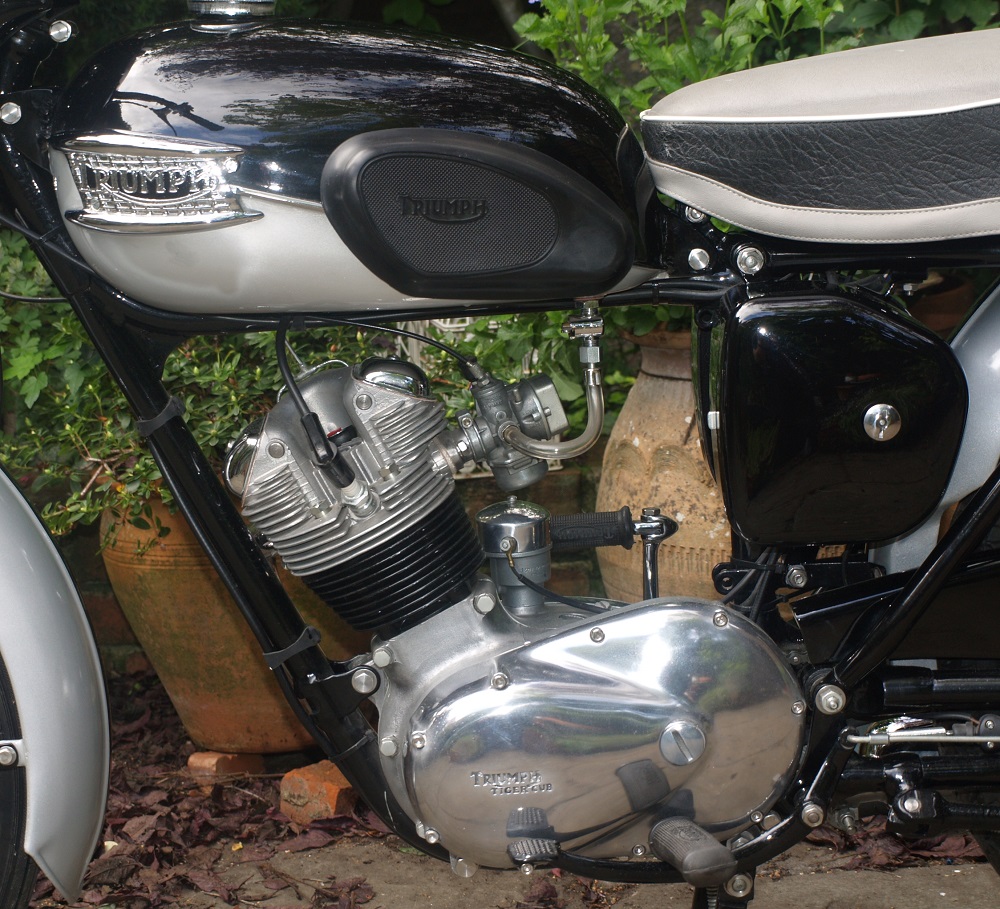
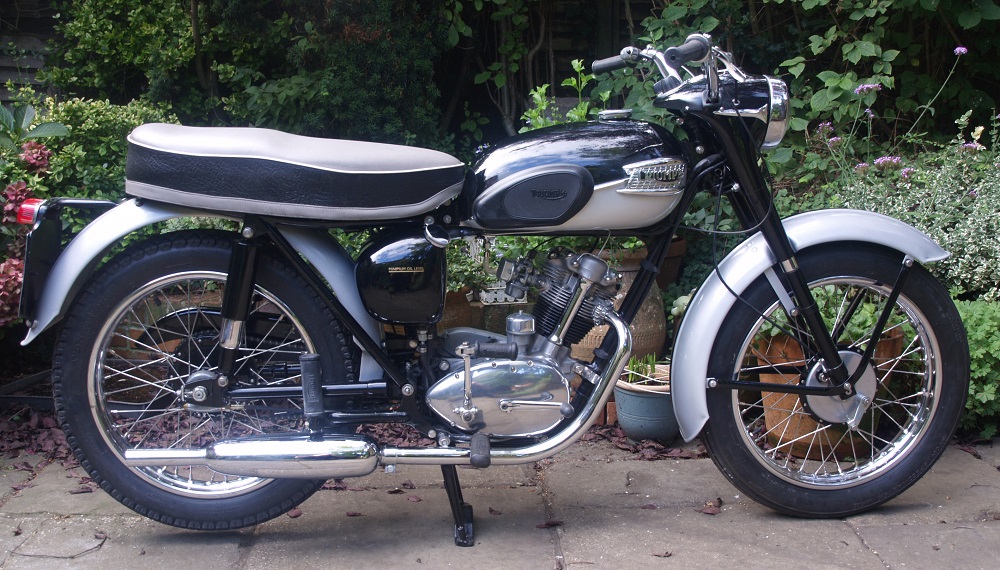
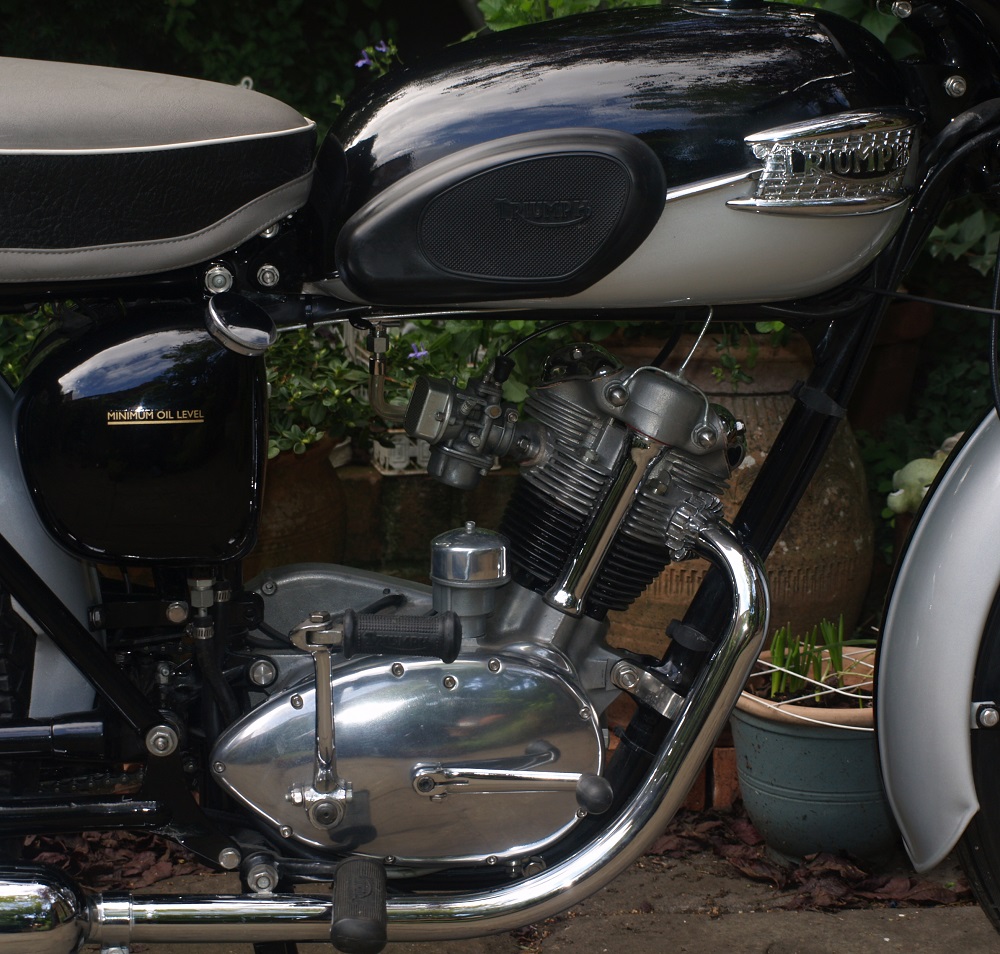 The engine was completely rebuilt without any real issues. However, I have a complete hatred to the use of bath tubs on Triumphs, having suffered badly from one on a 3TA, and so decided not to include the bikini cover on my restored Tiger Cub. Since the T20 came with a cut down mudguard for use with the bikini, I had to acquire a full length mudguard from a sportier Cub. One of the consequences of having the bikini cover fitted, is that it presses down on the back of the engine on either side and leaves tell tale grooves in the castings. If you are lucky, these can be removed by careful grinding and polishing but, in my case, the outer timing cover was too badly affected by the groove and had to be replaced.
The engine was completely rebuilt without any real issues. However, I have a complete hatred to the use of bath tubs on Triumphs, having suffered badly from one on a 3TA, and so decided not to include the bikini cover on my restored Tiger Cub. Since the T20 came with a cut down mudguard for use with the bikini, I had to acquire a full length mudguard from a sportier Cub. One of the consequences of having the bikini cover fitted, is that it presses down on the back of the engine on either side and leaves tell tale grooves in the castings. If you are lucky, these can be removed by careful grinding and polishing but, in my case, the outer timing cover was too badly affected by the groove and had to be replaced.
In the original restoration, all the chrome work was sent away to be re-chromed including the exhaust system. I had looked into replacing the silencer with a brand new one but, at the time, there was a problem with the pattern units available. I remember being confused when I saw these being advertised as being A, B or C pattern, if memory serves me correctly. When I enquired about the differences, I was told that the 3 types had the mounting bracket fitted in three different positions, all of them wrong! In the end, I re-chromed my original silencer.
The trickiest things to restore were the rear shock absorbers. It is impossible to get hold of the original design and so I decided to restore the old ones which are very difficult to take apart. Unlike Girling units which are held together by collets at the top of the upper covers, the Tiger Cub units are held together by the chrome plated lower covers that act as collets. To take them apart needs a special tool that is used to compress the springs inside the upper covers to release the pressure on the collets so that they can be released. Once apart, I repainted the shock absorbers where necessary and had the collets re-chromed. Assembling the shock absorbers afterwards was equally challenging but worth all the trouble in order to restore them to factory condition.
The front fork were restored with new stanchions, new seals and new bushes. These so-called lightweight forks work reasonably well but are not that strong compared with those fitted to other BSA and Triumph bikes. The really odd thing about these forks is that you have to re-fill the forks with oil through a small (3/16″ diameter) plug in the side of the stanchion within the headlight shell. Normally this would be done via the top nuts on the forks but, of course, these are inaccessible on the Cub because of the headlight nacelle top cover!
I had the wheels hub powder coated in the correct silver colour and then rebuilt the rims using stainless steel spokes and rims. New tyres and tubes were also fitted. All the control cables were replaced. The electrics were in relatively good condition and only needed some minor repairs to wiring harness. A new coil was fitted as was a new Lucas regulator.
The Cub’s frame was powder coated in black and the steering head and swinging arm bearings replaced. I spray painted all the bikes tinware in silver sheen and black as per original factory specification but the paint finish did not last the test of time and some 5 years later had deteriorated. This was mainly because of problems with the primer used at the time. Therefore, I recently decided to carry out another complete re-spray which involved sanding down all the original paintwork before stating over again. I am now a much more experienced spray painter than before and use a 2k clear coat to produce the excellent finish achieved.
Triumph T20 Tiger Cub Specifications
- Engine: Single cylinder, OHV, 2-valve, 4-stroke
- Starting: Kickstart only
- Capacity: 199 cc
- Bore/Stroke: 63 x 64 mm
- Compression Ratio: 7.0:1
- Max Power: 10 hp
- Carburettor: Zenith carburettor
- Cooling: Air cooled
- Lubrication: Dry sump
- Ignition: Coil and contact breaker points
- Transmission: 4 speed foot shift
- Final Drive: Chain
- Front Suspension: Coil spring and hydraulically damped
- Rear Suspension: Coil spring and hydraulically damped
- Front Brake: 5.5 inch drum single leading shoe
- Rear Brake: 5.5 inch drum single leading shoe
- Frame: Swan Neck
- Rake Angle: 65 deg
- Wheel Base 49 inch
- Seat Height: 29 inch
- Front Tyre 3.25 x 17 inch
- Rear Tyre: 3.25 x 17 inch
- Ground Clearance: 5 inch
- Dry Weight: 220 lb
- Fuel Tank: 3.0 gallons
- Oil Tank: 2.75 pints
Triumph Tiger Cub Parts Suppliers
Tiger Cub spares are not that easy to get hold off sometimes compared with other BSA and Triumph spares. The main supplier is Greystone Enterprises who I used extensively during the restoration of my Cub.
29,598 total views, 3 views today

